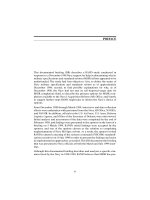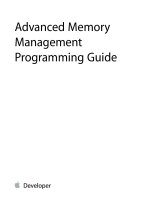Flash memory management with cooperation, adaptation and assistance
Bạn đang xem bản rút gọn của tài liệu. Xem và tải ngay bản đầy đủ của tài liệu tại đây (2.22 MB, 141 trang )
FLASH MEMORY MANAGEMENT
WITH COOPERATION, ADAPTATION
AND ASSISTANCE
CHUNDONG WANG
(B.Sc., XI’AN JIAOTONG UNIVERSITY, CHINA)
A THESIS SUBMITTED
FOR THE DEGREE OF DOCTOR OF PHILOSOPHY
DEPARTMENT OF COMPUTER SCIENCE
NATIONAL UNIVERSITY OF SINGAPORE
2013
DECLARATION
I hereby declare that the thesis is my original work and it has been written
by me in its entirety. I have duly acknowledged all the sources of informa-
tion which have been used in the thesis.
This thesis has also not been submitted for any degree in any university
previously.
Chundong Wang
November 14, 2013
i
Acknowledgements
First of all, my deepest gratitude goes to my supervisor, Professor Wong Weng
Fai, for his persistent and attentive guidance throughout my Ph.D. candida-
ture. Professor Wong always inspires me and encourages to do research. His
professional supervision is of great value to my career in the future.
I would like to express my sincere thanks to my dissertation committee mem-
bers, Professor Tulika Mitra, Professor Roland Yap Hock Chuan and Professor
Tei-Wei Kuo. They have spent a lot of time in reviewing my dissertation, and
given me insightful comments and suggestions.
I am grateful to teachers during my Ph.D. study. They did teach me not only
knowledge but all skills for a researcher. I also would like to thank administrative
staffs of the school and the university for their help in the past five years.
Many thanks are due to my fellows in the Embedded Systems Research Labs
and SoC, including Edward Sim, Ju Lei, Anderi Hagiescu, Liang Yun, Huynh
Phung Huynh, Sudipta Chattopadhyay, Liu Shanshan, Qi Dawei, Ding Hup-
ing, Chen Jie, Chen Liang, Pooja Roy, Wang Jianxing, Mamohan Manoharan,
Thannimalai Somu Muthukaruppan, Zhong Guanwen, Ramapantulu Lavanya,
Guo Xiangfa, Li Bo, Su Bolan and many others that are not listed. I want
to express my gratitude to Professor J¨urgen Teich in University of Erlangen-
Nuremberg, Professor Qi Yong, Professor Song Qinbao and Dr. He Liang in
Xi’an Jiaotong University, Dr. Yang Wentong in the National University Health
System, and Assistant Professor Yeh Chi-Tsai in Shih Chien University. I also
want to thank Wang Dong, Hai Zhen, Cheng Peng, Chen Peng, Hu Ping, Zhang
Kaibin and Li Zhenggang. I highly appreciate their encouragement and support.
I would love to extend the warmest thanks to my parents. They always
believe me and encourage me to pursue my dreams. Twelve years ago I left my
hometown for study. I wish we could live together soon after my graduation.
Finally, I want to thank my wife, Jiang Lina. I might not be able to write
this dissertation without her love and understanding. We met ten years ago in
our high school. She is always being supportive to me and helping me through
all the hard times. This dissertation is dedicated to her.
ii
Contents
Declaration i
Acknowledgements ii
Contents iii
Abstract vi
List of Publications viii
List of Tables ix
List of Figures x
1 Introduction 1
1.1 FlashMemoryManagement 1
1.1.1 NAND Flash Memory 1
1.1.2 FlashMemoryManagement 2
1.2 ProblemFormulationandMotivation 4
1.3 ThesisStatementandOverview 6
1.4 OrganizationoftheChapters 8
2 Background 9
2.1 NAND Flash Memory . . . 9
2.2 ModulesofFlashMemoryManagement 11
2.3 TheBackgroundoftheEra 14
3 Literature Review 15
3.1 FlashDeviceandItsPotential 15
3.2 AlgorithmsofFlashManagement 17
3.2.1 SchemesforWearLeveling 17
3.2.2 SchemesforAddressMapping 19
iii
3.2.3 SchemesforRAMBufferManagement 21
3.3 StrategiesBehindFlashManagement 23
3.3.1 Module-CooperativeFlashManagement 23
3.3.2 Workload-adaptiveFlashManagement 24
3.3.3 OS-involvedFlashManagement 25
4 OWL: Cooperative Wear Leveling 26
4.1 Overview 26
4.2 ChallengeandMotivation 28
4.3 OWL’sBlockOrganization 29
4.4 Locality-basedBlockAllocation 30
4.5 ScanandTransferScheme 34
4.6 ExperimentalEvaluation 37
4.6.1 ExperimentalMethodology 37
4.6.2 EffectivenessofOWL 38
4.6.3 EffectsofBATSize 40
4.6.4 EffectivenessofST 41
4.7 Summary 44
5 ADAPT: Workload-Adaptive Hybrid Address Mapping 47
5.1 Overview 47
5.2 OnlineAdaptivePartitioningoftheLogSpace 49
5.3 PredictiveTransfers 53
5.4 Aggregated Data Movement 56
5.5 MergeorMoveDecisionProcedure 57
5.6 Experiments 57
5.6.1 ConfigurationsandAssumptions 57
5.6.2 PerformanceEvaluation 59
5.6.3 EffectsofLogSpaceCapacity 62
5.6.4 EffectsofLogSpacePartitioning 63
5.6.5 Impact of κ 64
5.6.6 EffectsoftheIntervalLengthonAdaptation 64
5.6.7 EffectsofHATSize 65
5.6.8 Tuning of Aggregation Threshold 66
5.7 Summary 68
6 TreeFTL: An Adaptive Tree in the RAM Buffer 71
6.1 Overview 71
6.2 TheTreeinRAM 73
iv
6.2.1 TheThreeLevels 73
6.2.2 AddressTranslationWithTheTree 75
6.3 LightweightPruningofTreeFTL 77
6.3.1 LightweightPruningwithCachingGroups 77
6.3.2 Two-levelLRUSelectionMechanism 80
6.4 DiscussionsonTreeFTL 82
6.4.1 Partitioning and RAM Space Utilization 82
6.4.2 WorkloadAdaptation 82
6.4.3 Reliability and Garbage Collection 83
6.5 PerformanceEvaluation 83
6.5.1 ExperimentalSetup 83
6.5.2 PerformanceImprovementsbyTreeFTL 85
6.5.3 EffectoftheLightweightLRUSelection 88
6.6 Summary 90
7 SAW: OS-Assisted Wear Leveling 91
7.1 Overview 91
7.2 Temperature of File Types . 93
7.2.1 Update Frequency of A File Type 94
7.2.2 UpdateRecency 96
7.2.3 Temperature of File Types . . 97
7.3 WearLevelingwithTemperature 98
7.3.1 ExponentialDivisionofFlashBlocks 98
7.3.2 Temperature Adjustment 99
7.4 APrototypeofSAW 99
7.5 ExperimentalEvaluation 101
7.5.1 TheEffectivenessofSAW 102
7.5.2 The Accuracy of f for ϕ 105
7.5.3 The Impact of β 106
7.5.4 ImpactofIntervalLength 106
7.5.5 FullResultswiththePrototypeandFlashSim 107
7.6 Summary 107
8 Conclusion 113
8.1 ThesisContributions 113
8.2 FutureDirections 114
Bibliography 115
v
Abstract
NAND flash memory-based devices are ubiquitous for data storage in smart
phones, personal computers and enterprise servers today. This can be attributed
to the advantages of NAND flash memory over ferromagnetic material and
volatile memory; in particular, they are lightweight, shock-resistance, energy-
efficiency and non-volatility. However, NAND flash memory has inherent char-
acteristics that are still serious concerns in its deployment. At the same time, the
environments in which storage devices are used have become much more diverse
in the past three decades since the invention of flash memory. Efficient and ef-
fective strategies to manage flash device are therefore necessary. This motivates
us to innovate new approaches within this thesis.
The management of a NAND flash device is traditionally done by an em-
bedded software called the flash translation layer (FTL). The FTL is developed
in a modular design with each module being responsible for one aspect of flash
management. For example, address mapping maps logical addresses of file sys-
tems to physical addresses of flash memory; wear leveling attempts to commit
all flash blocks to age at a similar rate, and RAM buffer management aims to
make the best use of the RAM buffer inside a flash device.
Our first idea is to have the modules of the FTL cooperate with one another.
Modules are likely to have different and possibly independent perspectives with
regards to flash management. Therefore, a module of the FTL may benefit from
the knowledge of another. Based on this idea we have developed OWL. It is a
wear leveling algorithm that works within hybrid address mapping. The latter
vi
classifies allocation requests when allocating blocks for data storage. Coopera-
tion between them goes beyond simply exchanging information. Instead, a part
of the wear leveling module of OWL is co-developed with the hybrid mapping
module so as to incorporate the latter’s information and consideration upon
deciding which block to be allocated.
Workload adaptation is our second idea. Flash-based storage devices serve
workloads to store and access data. The ability of adapting to a given workload
is essential due to the diversity of workloads. Address mapping and RAM buffer
management are two functionalities of the FTL that relate to data access. We
have first designed a hybrid mapping scheme named ADAPT. ADAPT achieves
the goal of workload adaptation through separating and handling respective
sequential and random requests. TreeFTL is another scheme we have devised to
manage the RAM buffer of a flash device. TreeFTL caches metadata of address
mapping and real data pages in the RAM space using a tree-like structure. To
minimize the overheads of context switch between workloads, TreeFTL has a
lightweight mechanism for evicting the LRU victims to make space.
Our third idea is to enlist the help of the operating system (OS). Traditionally
the FTL is self-contained and the OS is oblivious of storage devices. As the OS
has a global perspective of data and files, we would like to use the OS’s knowledge
to assist the FTL to manage flash device. The result of this collaboration is a
scheme we called SAW, of which the OS analyzes files to figure out quantitative
hints for the FTL to perform wear leveling. Correspondingly the FTL customizes
its block organization to utilize the hints received from the OS. Hints are packed
along within data segments and delivered to the FTL. The FTL unpacks each
segment, interprets the hint and conducts block allocation accordingly.
Experiments have been conducted to evaluate our proposals. Results confirm
that our approaches in this thesis could gain significant improvements on device
lifetime and access performance, respectively, with insignificant overheads.
vii
List of Publications
1. Chundong Wang and Weng-Fai Wong. Observational wear leveling: an effi-
cient algorithm for flash memory management. In Proceedings of the 49th An-
nual Design Automation Conference, DAC ’12, pages 235–242, San Francisco,
California, USA, 2012. ACM.
2. Chundong Wang and Weng-Fai Wong. Extending the lifetime of NAND
flash memory by salvaging bad blocks. In 15th Design, Automation, and Test
in Europe (DATE 2012) conference, pages 260–263, Dresden, Germany. March
2012.
3. Chundong Wang and Weng-Fai Wong. ADAPT: Efficient workload-sensitive
flash management based on adaptation, prediction and aggregation. In Proceed-
ings of the 2012 IEEE 28th Symposium on Mass Storage Systems and Technolo-
gies, MSST ’12, Pacific Grove, California, USA, April 2012.
4. Chundong Wang and Weng-Fai Wong. TreeFTL: Efficient RAM Management
for High Performance of NAND Flash-based Storage Systems. In Proceedings of
the 16th Design, Automation and Test in Europe Conference, DATE ’13, pages
374-379, Grenoble, France. March 2013.
5. Chundong Wang and Weng-Fai Wong. SAW: System-assisted wear leveling
on the write endurance of NAND flash devices. In Proceedings of the 50th An-
nual Design Automation Conference, DAC ’13, pages 164:1-164:9, Austin, Texas,
USA, 2013. ACM.
viii
List of Tables
3.1 ASummaryoftheLatestWearLevelingAlgorithms 17
4.1 BlockAllocationRatiosinFAST 29
4.2 CapacitiesforTraces 37
5.1 I/ORequestSizeofVariousWorkloads 48
5.2 Latencies of Large-block SLC NAND Flash Memory [38] 54
5.3 Prediction Hit Rates and Aggregated Moves 62
6.1 Latencies of SLC NAND Flash Memory [41] 74
6.2 Hit Ratios (%) of APS, JTL and Tree 87
7.1 SymbolsofSAWModel 95
7.2 Mean Difference of Standard Deviation with Five Intervals (I) . 106
7.3 Average Erase Count, Standard Deviation, the Counts of Write
and Read Operations of baseline, BET and SAW (1stTime) 108
7.4 Average Erase Count, Standard Deviation, the Counts of Write
and Read Operations of baseline, BET and SAW (2ndTime) 109
7.5 Average Erase Count, Standard Deviation, the Counts of Write
and Read Operations of baseline, BET and SAW (3rdTime) 110
7.6 Average Erase Count and Standard Deviation of 5k, 10k, 15k,
20k and 25k 111
7.7 Average Erase Count, Standard Deviation and Service Time of
lazy and lazy-S 112
ix
7.8 Average Erase Count, Standard Deviation and Service Time of
BET and BET-S 112
7.9 Average Erase Count, Standard Deviation and Service Time of
OWL and O-SAW 112
x
List of Figures
1.1 A Logical Structure of NAND Flash Devices 3
1.2 TheFlashMemoryManagement 4
2.1 Structures and Operations of NAND Flash Memory 9
2.2 PageMappingandBlockMapping 13
3.1 Threetypesofmerge(adoptedfromLeeetal.[62]) 21
3.2 Page-levelMapping:DFTLandCDFTL 22
4.1 Locality-basedBlockAllocationwithBAT 31
4.2 AnExampleofSTScheme 36
4.3 AverageEraseCountsofEachTrace 38
4.4 StandardDeviationofEraseCounts 39
4.5 ElapsedTimewithFourAlgorithms 39
4.6 TheEffectsofDifferentBATSize 40
4.7 TheEffectsofSTwithVariousδ (A) 41
4.8 TheEffectsofSTwithVariousδ (B) 41
4.9 The Effects of λ length 42
4.10NormalizedElapsedTimewithVariousΓ 43
4.11NormalizedAverageEraseCountwithVariousΓ 44
4.12StandardDeviationwithVariousΓ 45
5.1 Predictive Transfer with the Historical Access Table 55
5.2 Aggregated Data Movement 56
xi
5.3 Normalized Elapsed Time of DFTL, WAFTL and ADAPT . . . 60
5.4 NormalizedEraseCountsofWAFTLandADAPT 60
5.5 NormalizedWriteCountsofWAFTLandADAPT 61
5.6 EffectsofDifferentLogSpaceCapacities 63
5.7 PerformanceImpactofLogSpacePartitioning 64
5.8 Impact of Different Sequential Write Identification Thresholds . . 65
5.9 The Effects of κ (A) 65
5.10 The Effects of κ (B) 66
5.11 Captures of Access Distribution for SPC1 and MSR-prxy
0 67
5.12TheEffectsoftheIntervalLength(A) 68
5.13TheEffectsoftheIntervalLength(B) 68
5.14EffectsofDifferentHATSizes 69
5.15 Performance of Aggregated Movement 70
6.1 AConceptualStructureofTreeFTL 74
6.2 Address Translation Process in TreeFTL . . 76
6.3 TheSketchofTreeFTL’sVictimSelection 78
6.4 The Sketch of TreeFTL’s Two-level LRU Selection Mechanism . 80
6.5 NormalizedServiceTimeforTraces(1) 84
6.6 NormalizedServiceTimeforTraces(2) 85
6.7 Captures of Access Distribution for TPC-C and MSR-ts
0 86
6.8 Cumulative Service Time and Average Size of CG for Traces at
Runtime 89
6.9 EffectofLightweightVictimSelection 90
7.1 ASketchofSAWPrototype 100
7.2 AverageEraseCountwithPrototype 101
7.3 StandardDeviationofEraseCountswithPrototype 102
7.4 AverageEraseCountwithFlashSim 103
7.5 StandardDeviationofEraseCountswithFlashSim 103
xii
7.6 ServiceTimewithFlashSim 104
7.7 Fluctuation of f/ϕ (Clockwise: PM-5m, PM-10m, FS-2h, VM-2h) 105
7.8 s and β at Runtime (Clockwise: PM-5m, PM-10m, FS-2h, VM-2h)105
xiii
Chapter 1
Introduction
The advent of flash memory has changed the persistent data storage of computer
systems. NAND flash memory’s non-volatility, lightweight, shock-resistance and
scalability make it a promising candidate for the secondary storage in both em-
bedded systems and general-purpose computing systems. However, the ever-
increasing utilization of NAND flash memory comes with its challenges. On the
one hand, the environments in which NAND flash memory is used today vary
significantly. For example, the access pattern of a smart-phone is very different
from that of an enterprise server. On the other hand, NAND flash memory has
been evolving to be denser and weaker than before. Also, the products made
of NAND flash memory are getting diverse; they can be either emulated to be
block devices or just exposed as raw flash devices. In all, these challenges neces-
sitate revising existent strategies for managing NAND flash-based device. This
thesis will hence present novel approaches on the management of NAND flash
memory. Several management algorithms, which target either longer device life-
time or higher access performance, have been developed accordingly in order to
achieve satisfactory effectiveness and efficiency.
1.1 Flash Memory Management
1.1.1 NAND Flash Memory
NAND flash memory is preferred in hand-held products like smart-phones, dig-
ital cameras and tablet computers, because of its lightweight and resistance to
damage during movements [50]. Simultaneously, flash-based solid state drives
(SSDs) are starting to replace traditional ferro-magnetic hard disk drives (HDDs) [1,
78]. Both personal computers (PCs) and enterprise servers have been utilizing
flash-based SSDs for secondary storage. For example, the MacBook Air laptops
1
CHAPTER 1. INTRODUCTION
of Apple inc. are mature in marketplace. In 2008 Google announced a plan to
use Intel SSD storage in its servers [20]. Later in the autumn of 2009, MySpace
migrated its data from HDDs to SSDs produced by Fusion-io [72].
A NAND flash device consists of multiple flash memory chips. In a NAND
flash chip there are hundreds of thousands of flash cells. Each flash cell has
a single transistor with an extra metal strip, which is called the floating gate
between the control gate and the oxide tunnel [5, 27, 89, 7]. To store data into a
cell has to program it, which means to place a very high voltage to drive electrons
to approach the floating gate. However, electrons will stay there unless a reverse
voltage is applied to pull them off the floating gate. Such a process is referred
to as an erase operation. Note that an erase operation takes a much longer time
than a program operation. So it is unacceptable to update “in place” as the time
caused by an additional erase operation is too costly. Herein lies the first key
issue of NAND flash memory, which is, data have to be updated in an out-of-
place way: data to be updated are first written into a clean page and the original
page of the data is invalidated to be dirty. Another issue is the units of the said
program and erase operations for flash memory. Because of the fabrication, the
unit for a program operation of NAND flash memory is a page, and the unit
for an erase operation is a block. Generally a page consists of thousands of
flash cells, and a block comprises scores of pages. The out-of-place updating and
the access unit constraints are the main concerns for the improvement of access
performance of NAND flash memory-based devices.
The third issue of NAND flash memory also comes from the flash cell struc-
ture. The oxide layer of the cell, the one that isolates the electrons of the floating
gate, is alternatively strained by continual program and erase operations for stor-
ing data [82]. In a long run, the oxide layer would be punctured after too many
P/E cycles [79]. Then the cell cannot store data any longer. A page that has
a permanently defective cell is deemed to be “worn-out”. It in turn makes the
block it is in worn out. A worn-out bad block is supposed to be kept away from
regular use [39, 67]. Worse, a flash chip that has excessive worn-out blocks has
to be discarded. Such an issue is referenced as the write endurance of NAND
flash memory. It adversely impacts the lifetime of NAND flash devices.
1.1.2 Flash Memory Management
The characteristics of NAND flash memory, including access unit constraints,
out-of-place updating and write endurance, are the foundation of all strategies
for flash memory management. There are three goals for the flash memory
management. First, the utilization of flash blocks and pages should be as high
2
CHAPTER 1. INTRODUCTION
Host
Interfaces
Embedded
Processor
Flash
Controller
FTL
RAM Buffer
Host
…
…
Chip 0
Chip 1
Chip2
Chip N-2
Chip N-1
Flash Chips
Figure 1.1: A Logical Structure of NAND Flash Devices
as possible. Second, the performance of data access must be optimal. Third,
the lifetime of flash device has to be entailed without too much performance
degradation [44, 95].
Figure 1.1 shows the logical structure of a common NAND flash device. It
has an interface like USB or SATA that connects to the host system. Inside
the flash device an embedded processor is equipped for computation. The RAM
cache, also referenced as RAM buffer in some literatures, is used to buffer data
and metadata. The flash controller conducts write, read and erase operations on
flash chips. The FTL, which is abbreviated for the flash translation layer,isthe
embedded firmware that is responsible for the management of a flash device.
The functionalities of flash memory management include address mapping,
wear leveling, bad block management (BBM), RAM buffer management and
garbage collection, as is sketched in Figure 1.2. Address mapping is also known
as address translation. We will use them interchangeably in this thesis. Address
mapping is to map logical addresses given by the host file system to physical
addresses in the form of flash block and page. Owing to the constraints of access
units as well as out-of-place updating, address mapping of flash device is not that
straightforward. Wear leveling is a technique targeting the issue write endurance
of flash memory to avoid premature retirement of flash blocks. It aims to even
out erase operations across all flash blocks. So it is used to ensure that flash
blocks are worn at the same rate. Though, blocks may still go worn-out, and
BBM is employed to trace them. RAM buffer is an important component of
NAND flash devices. SRAM or DRAM has much shorter latency than NAND
flash memory, and to utilize a RAM cache for buffering may favorably affect
access performance of NAND flash devices. Garbage collection, also known as
the reclamation, is caused by out-of-place updating that leaves invalid, obsolete
3
CHAPTER 1. INTRODUCTION
Flash Memory
Management
Wear
Leveling
Bad Block
Management
RAM
Management
Address
Translation
Lifetime Performance
OWL (DAC 2012)
BBS (DATE 2012)
SAW (DAC 2013)
BBS (DATE 2012)
ADAPT (MSST 2012)
TreeFTL (DATE 2013)
TreeFTL (DATE 2013)
Figure 1.2: The Flash Memory Management
data behind. Such dirty data have to be demolished. The blocks and pages they
take up can be vacated and cleaned for further use.
All the above functionalities of flash management are performed by one en-
tity, i.e., the mentioned FTL. The FTL may be presented or named in different
ways [68]. Here we reference them uniformly as the FTL for the ease of discus-
sion. The FTL is designed in a modular way; each module of the FTL works
on one functionality of flash management. Though, how to develop a module
deserves special attention as it is not trivial to hold both the effectiveness and
the efficiency simultaneously in hand.
1.2 Problem Formulation and Motivation
The ever-increasing utilization of NAND flash memory indicates the bright future
of flash devices. As the dollar/capacity offered by flash-based storage devices is
continuously decreasing, the utilization would be further boosted. However, the
concomitant challenges are ignorable. The dropping of price for NAND flash
memory is partially caused by the Multi-Level Cell (MLC) technique to produce
flash memory. Briefly speaking, a traditional flash cell can store only one bit per
cell, which is called Single-Level cell (SLC) flash. Using MLC technique, two [61]
or more [54] bits now can be stored just within one single cell. Since flash memory
can be manufactured to be much denser with MLC technique, the reduction of
production cost is not beyond expectation. However, the reduction of price is
not free of charge on other aspects. Empirical evidence of worsening lifetime
and reliability, as well as access performance, of MLC flash memory has been
reported [27]. Though, MLC flash is still considered to be the mainstream in
4
CHAPTER 1. INTRODUCTION
marketplace [28], and most low-end and middle-level SSDs are made of MLC flash
chips [15]. The two-fold MLC flash and its prevalence dictate that the embedded
software to manage a flash device, i.e., the said FTL, should be fittingly designed
to provide satisfying device lifetime and access performance.
Besides the issue of the development of NAND flash memory, which is derived
from the innate characteristics of flash itself, the situations where flash device is
being environed turn to be a concern also. Different workloads differently impose
on the storage device. As access performance and write endurance of flash device
are strongly correlated to the workload in service, to be adaptive to workload is
widely advocated by researchers and practitioners [1, 15, 17, 45, 64, 78, 111]. A
common way to speculate the access behavior of a workload is to assess the ratio
of sequential to random requests. Sequential requests are ones that access a large
number of pages. Random requests selectively access a handful of pages among
a wide range. Flash-based device is believed to be favored by workloads with a
high demand for random access requests [78] as flash memory need not rotate the
actuator to locate the desired position like ferromagnetic hard disk. Nevertheless,
random writes in a large storage space may lead to excessively long response
latency, owing to write amplification caused by inevitable garbage collection
as well as wear leveling [15, 33]. Worse, because of out-of-place updating, the
various workloads of access requests result in various layouts of data across flash
blocks. This may not be a big deal for hard disk, or byte-addressable SRAM and
DRAM as they support in-place rewriting; for NAND flash memory, however,
to recycle used space badly impacts access performance and device lifetime.
Therefore, it is desirable for a flash device to have a good understanding of
workloads for serving them.
In all, both the flash memory itself and its utilization motivate us to rethink
of how to manage flash device. On the one hand, the management of flash
device must highly regard the specifics of NAND flash memory. The aforemen-
tioned address mapping, for example, is not merely to map addresses; to allocate
flash pages and blocks is one of its duties. The allocation of blocks and pages
must abide by access constraints and erase-before-program issue of NAND flash
memory. As for wear leveling, it is just employed to target the issue of write
endurance of flash.
On the other hand, the management of flash device ought to be self-adaptive
to various workloads. Existing strategies of previous works, however, have lim-
itations on the adaptation. For example, FAST [60] is a classical FTL that
was proposed for mapping addresses. It judiciously utilizes the access units of
flash memory as well as out-of-place updating in managing blocks and pages to
5
CHAPTER 1. INTRODUCTION
accommodate data, but it lacks on the ability of handling sequential requests.
The successor of FAST, the FASTer FTL [64], emphasizes on workloads found
in OLTP systems. But OLTP system just represents one type of workloads.
The third perspective on flash device is to view it in a systemic way. Flash
device is used for secondary storage in a computer system. It is not irrelevant to
other components of the integration. Two implications lie herein. Firstly, flash
device serves the upper-level OS to store and access data; in other words, it con-
ducts communications with OS. So it is able to obtain substantial information
from the OS for the purpose of managing flash device. TRIM command [21],
which engages the modern OS in informing flash device of reclaiming space in
advance, shows the feasibility of notification from the OS to the FTL. Although
the TRIM command is simple, more complicated exchange is implied to be pos-
sible. Secondly, the management of flash device can be enhanced using the ideas
reflected in other parts of the computer system. For example, the mentioned
FAST FTL uses the idea of CPU cache for address mapping. The page man-
agement of virtual memory [97], as well as the virtual RAM drive constructed
by a part of main memory [2], shares similar points with flash device as well.
However, as flash itself differs from DRAM-based main memory, they cannot be
directly applied to flash device. Though, their ideas are still referential to us.
1.3 Thesis Statement and Overview
Given the challenges described above, the aim of this thesis, is to propose novel
strategies for flash management which, on the one hand must take into consider-
ation the idiosyncratic characteristics of NAND flash memory, and, on the other
hand should be effective and efficient for a variety of workloads. With these in
mind, we have taken three approaches to the problem. Since the FTL is the main
agent in charge of managing a flash device, it is natural to start by exploring
the internals of the FTL. Thus in the first approach we proposed new modes of
the cooperation between modules of the FTL. A module is responsible for one
functionality and it has its particular perspective with regards to flash manage-
ment. The cooperation we proposed is not simply exchanging of messages in
between. Rather it is the co-development of modules; a part of one module is
embedded into another so as to gain immediate information on the nature of the
ongoing accesses. By doing so it is expected that one module can benefit from
the sharing with another one.
As flash device needs to be able to handle various workloads, our second at-
tempt is on the workload adaptation of FTL modules. In other words, we intend
6
CHAPTER 1. INTRODUCTION
to construct workload-adaptive modules. As a workload is nothing more than a
series of consecutive access requests, the access behavior of a running workload
can be learnt accordingly. The learning in turn helps the FTL handle future
requests. In the end the management algorithm is able to adapt to different
workloads.
The third approach we have explored is on the collaboration between the
OS that sits in the upper level and the FTL that is in the lower-level storage
device. The OS has good knowledge of applications, files and data, which is not
available to the FTL. On the other side, the FTL autonomously manages the
flash device in a manner that is transparent to the OS. So we involve the OS
in the process of flash management. With the assistance of the OS, the FTL
should profit from this involvement.
The main contributions of this thesis, also main ideas of this thesis, are as
follows.
• Inter-module cooperation-based management for flash device is investi-
gated. An algorithm for wear leveling, namely Observational Wear Lev-
eling (OWL) [105] is proposed. The wear leveling module of OWL is co-
developed within the address mapping module. By doing so, OWL can
succinctly classify data and accommodate them accordingly.
• Schemes for workload-adaptive address mapping and RAM buffer manage-
ment have been proposed. ADAPT [103] is for address mapping and it is
able to serve workloads that have variant mixes of sequential and random
requests. TreeFTL [107], which manages the RAM buffer of flash device,
can dynamically adapt to workloads as it has a self-adjustive structure
maintained in the buffer.
• OS-assisted flash management has been studied. An algorithm named
OS-Assisted Wear leveling (SAW) [106] was devised. The wear leveling
of SAW relies on the OS’s hints. The OS is responsible for the analysis
over a massive number of files with a model, and the FTL performs wear
leveling as it is notified. According to the idea of SAW, a prototype has
been established upon open-source systems.
The effectiveness as well as efficiency of these approaches have been verified to
be evident and significant by our experiments. We believe that our proposals are
positive contributions to the field of flash memory management. We also hope
that our explorations will help practitioners improve existing designs. Besides
the widespread presence of flash device in mobile systems like smartphones,
7
CHAPTER 1. INTRODUCTION
netbooks and tablet computers, it is also clear that flash memory will play an
important role in the next generation of secondary storage for general-purpose
computing systems. To summarize, we believe our proposals to be described in
following chapters of this thesis will improve the utilization of flash-based storage
devices in the near future.
1.4 Organization of the Chapters
In this thesis, the three said approaches with several novel schemes would be
described. This chapter has introduced an overview of NAND flash memory,
flash-based device and the motivation for novel flash management strategies.
Chapter 2 will give a detailed background of NAND flash memory. Chapter 3
surveys flash device and state-of-the-art schemes that were proposed for flash
memory management. They are for different functionalities and the essence of
their designs would be discussed. Chapter 4 is what we did to verify the effect of
the module-cooperative approach. It presents the Observational Wear Leveling
(OWL). For OWL, the module of address mapping assists the module of wear lev-
eling to allocate flash blocks to data. In other words, address mapping classifies
data and wear leveling accommodates them subsequently. Through cooperation
the wear evenness is significantly improved with ignorable performance over-
heads. Chapter 5 and Chapter 6 are our attempts to develop workload-adaptive
modules for flash management. Chapter 5 presents ADAPT. As mentioned,
ADAPT is able to be adaptive to workloads that are variously mixed with ran-
dom accesses and sequential accesses. Chapter 6 proposes an algorithm named
TreeFTL [107] for RAM buffer management. TreeFTL is succinctly sensitive to
running workloads. It adapts to workloads by dynamically partitioning the RAM
space for buffering data and mapping addresses. The performance improvement
has been reported through the employment of TreeFTL and ADAPT, respec-
tively. Chapter 7 is about the OS-Assisted Wear leveling (SAW). For SAW, the
OS is not unaware of flash memory management any longer. Instead, the FTL
conducts wear leveling with hints provided by the OS. The hints are generated
online through a model over a large number of files. The wear evenness is con-
sequently improved due to the participation of the OS. Chapter 8 will conclude
this thesis and possible future works would be briefly presented.
8
Chapter 2
Background
This chapter gives an overview of NAND flash memory as well as tactics pre-
ferred for flash memory management. It first details physical characteristics of
NAND flash memory, including issues about flash cells, out-of-place updating
and write endurance. Following these are aspects of flash memory management,
including the modules of wear leveling, address mapping, RAM buffer manage-
ment and bad block management, etc.
2.1 NAND Flash Memory
NAND flash memory was invented by Masuoka et al. [71] of Toshiba. Its full
name could be NAND flash Electrically Erasable Programmable Read-Only
Memory (EEPROM or E
2
PROM) [89]. All the characteristics of NAND flash
memory, as well as the modules of flash management firmware, are based on the
structure of a NAND flash cell.
Block
Page
Chip
Bit Line (in)
Bit Line (out)
Word n
Word n+1
Word n+2
p-substrate
n+ S
n+ D
12V
p-substrate
n+ S
n+ D
12V
Control Gate
Floating Gate
Tunne ling oxide layer
6V
(a) Erase
(b) Program (write)
Figure 2.1: Structures and Operations of NAND Flash Memory
9
CHAPTER 2. BACKGROUND
Flash Cell, Page and Block Figure 2.1 shows a sketch of the structure
of a flash cell, with erase and program operations alongside. A flash cell is a
transistor with an extra floating gate. Flash memory makes use of charge stored
on the floating gate to accomplish the non-volatile storage [7]. The floating
gate is a metal strip between the control gate and the tunnelling oxide layer of
the transistor. It is sandwiched with oxide insulators, which enables the cell to
retain charge for a long period of time even if the circuit power supply is cut
off. To program or erase a flash cell is just to drive electrons. When the erase
operation is conducted, under the voltage the electrons at the floating gate will
be ejected to the source by tunnelling. The cell after an erase operation is in the
‘1’ state. To program a cell to be ‘0’ state, a reversed voltage must be applied
to the control gate, and then electrons are driven to approach the floating gate.
SLC flash and MLC flash There are two types of NAND flash memory.
One is single-level cell (SLC) flash memory of which each cell stores one bit. On
the other hand, a cell of multi-level cell (MLC) flash is able to store two bits or
more. Note that for SLC flash memory whether the bit is ‘1’ or ‘0’ is decided
through sensing the voltage. The range of the voltage is divided into two halves
with a threshold. If the voltage sensed is higher than the threshold, it is deemed
to be ‘1’. Otherwise it is ‘0’. For MLC flash, more thresholds are inserted to
set up more divisions over the voltage range. For example, if the range of the
voltage is divided into four quarters, the cell can represent ‘00’, ‘01’, ‘10’ and
‘11’; commonly two bits are stored in an MLC flash cell [26]. Products that
have three bits stored in a cell are available in marketplace today. However, the
increase of density is at the cost of the worsening endurance for a flash cell.
Out-of-place updating To do in-place updating is not reasonable for
NAND flash memory. It is due to the physical characteristics of the flash cell. As
is mentioned, electrons are trapped until an erase operation is conducted to pull
them away. Considering the access units of NAND flash memory, to update data
requires that a page should be rewritten. A flash page cannot be individually
erased unless the whole block it is in is erased. Put in another way, if we tried
to do in-place updating on a single page, we would have to rewrite all pages in
a block after an erase operation. In this way the overhead caused by a write
operation would be too significant due to many writes plus one erase operation.
Out-of-place updating is yet acceptable. Every time data in a page are to be
updated, an erased page will be allocated to accommodate them; the original
page will be invalidated then.
Write endurance The issue of write endurance is another problem of
NAND flash memory, which is also ascribed to the physical characteristics of flash
10
CHAPTER 2. BACKGROUND
cells. It is obvious that both program operation and erase operation alternatively
strain the oxide layer of a cell through applying voltages to drive electrons. After
undergoing too many program/erase (P/E) flips (the reversals of voltage), finally
the oxide layer cannot isolate the floating gate any longer. The limitation for
MLC NAND flash memory is much tighter than SLC flash. For the former, it
is about 10,000 cycles for a page; for the latter, it is about 100,000 cycles. As
is said, the range of the voltage for NAND flash memory is divided into more
parts. To program the bits for writing requires much more elaborate techniques.
The finer adjustment adversely impacts the physical tolerance of the flash cell.
This explains why MLC flash devices have a much shorter lifetime. For SLC
flash devices, though it has a longer lifespan, the upper bound of P/E cycles is
still not so satisfying for use.
2.2 Modules of Flash Memory Management
The said flash translation layer (FTL) is the one that is responsible for the
management of flash device. It can be found in flash-based block devices, such
as SSDs or USB sticks. In an MTD device made of raw flash [98], it is presented in
another form. As their functions are identical, we will reference them uniformly
as the FTLs for the ease of discussion.
The FTL emulates flash devices like traditional block-interface devices to hide
special characteristics of NAND flash memory. Main functionalities of flash man-
agement, including wear leveling, address translation, bad block management,
RAM buffer management and garbage collection, are represented by respective
modules of the FTL. We will first give an overview of wear leveling and address
translation, as they are two basic modules for flash memory management.
Wear Leveling Wear leveling targets the issue of write endurance of flash
memory. As is mentioned, limited program/erase flips exist for a flash page.
However, previous algorithms of wear leveling mostly focus on erase operations
as the physical limitation is mainly caused during the erasing procedure [89]. On
the other hand, to reduce program/erase flips at the page-level is not reasonable
as the unit of erase operations is a block. Besides, the coarser granularity of
erasures can ease the module of wear leveling. Hence, it is preferred for wear
leveling to spread erase operations over flash blocks.
Wear leveling’s common tactic is to classify data and put them into suitable
aged blocks. To do so a data structure called the block aging table (BAT) is
needed [40]. It is used to record the age of each block. The age here refers to
the erase count of a flash block. The more the erase count, the older the flash
11









